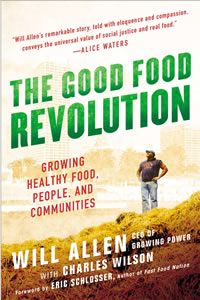 Will Allen grew up on a small farm in the Maryland suburbs of Washington, D. C. His parents grew up as sharecroppers in western South Carolina, very close to the home of J. Drew Lanham. As a young man, he was embarrassed by his heritage, instead hoping to make his career as a basketball player.
Will Allen grew up on a small farm in the Maryland suburbs of Washington, D. C. His parents grew up as sharecroppers in western South Carolina, very close to the home of J. Drew Lanham. As a young man, he was embarrassed by his heritage, instead hoping to make his career as a basketball player.
A talented competitor in both high school and college, he had a limited career as a professional, primarily playing in Belgium. While in Europe, he had time to observe the local agricultural customs, including the many small farms using traditional, organic practices. This reawakened in his interest in growing food. After starting a successful corporate career in metropolitan Milwaukee, he began farming as a hobby.
In 1993 by chance, he discovered the last agriculturally zoned property in the poor, mostly black northern part of the city. At the time he was in his forties, doing well in his career, but feeling unfulfilled. He decided to purchase the property, leave his safe job, and open a vegetable stand because he “wanted to try to heal the broken food system in the inner-city community where my market operated.”
He also wanted to connect Wisconsin farmers to African American communities, especially as Milwaukee is one of the most segregated cities in the country. “But on our small piece of earth, we struggled and celebrated together—black and white, Hispanic and Hmong, young and old—as we worked to produce healthy food.”
This hasn’t been easy, and much of “The Good Food Revolution” by Allen (with Charles Wilson) is the story of the last 20 years of building what is now a very successful urban farming non-profit organization that not only serves its home community but has fostered similar programs in many other cities. The author is a good storyteller, praising the many individuals who contributed to his work, so that they become your heroes, too. While this work is not a panacea to all of the troubles of racism and poverty, there are many happy endings.
Excerpted from the Winter 2018 Arboretum Bulletin.